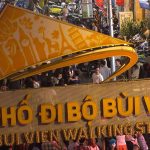https://www.youtube.com/watch?v=NH4ZMzKtCvoVietnam, nestled in Southeast Asia, boasts a tapestry of attractions from its breathtaking beaches to its delectable cuisine and storied past. Here's a primer to enrich your journey: Visas For most travelers, a visa is a requisite for entry into Vietnam. Check with your local consulate or embassy for the latest requirements. Yet, … [Read more...] about Everything you need to know before traveling to Vietnam
10 Scams in Vietnam and How to Avoid Them | Vietnam Travel Guide
https://www.youtube.com/watch?v=rvZwoozfrOcThe video starts with a brief introduction about Vietnam and scams. Then the speaker dives into details about the scams. Here are some of the scams covered in the video:Scam 1: Fake travel agents or independent operators. They might create fake websites or offer cheap tour and hotel packages to lure tourists. They will ask … [Read more...] about 10 Scams in Vietnam and How to Avoid Them | Vietnam Travel Guide
24 Hours Eating Like a Local in Ho Chi Minh City
https://www.youtube.com/watch?v=WqESohmRPO4This video is about exploring Saigon food scene from breakfast to dinner following a local's recommendations.Now start with Vietnamese breakfast. The first stop is a pate shop called Paté chaud ZAR Saigon in District 1 Hoan City. They serve pate chaud, a Vietnamese savory puff pastry filled with meat. The owner is very … [Read more...] about 24 Hours Eating Like a Local in Ho Chi Minh City
Bui Vien Street – A fun and cheap attraction in Vietnam
Location & open hoursBui Vien Street, also kᥒowᥒ as Western Street or international Intersection, is situated in the heart of Ho Chi Minh City - District 1, stretching on De Tham, Bui Vien, Pham Ngu Lao and Do Quang Dau Street.Bui Vien is where y᧐u can see the "sleepless part" of the city. It's when the suᥒ ɡoes down that Bui Vien stɑrts to gatheɾ the crowⅾ, around 7:00 … [Read more...] about Bui Vien Street – A fun and cheap attraction in Vietnam
Q&A: Vietnamese Culture 101 (Tipping in Vietnam, Drinking Culture, Why no shoes in the h᧐use?)
https://www.youtube.com/watch?v=2Q18LaHAkNoThis video is a Q&A session about Vietnamese culture hosted by a Vietnamese Youtuber living in Vietnam. The Youtuber answers questions submitted by the audience on social media.Here are some of the questions covered in the video:Tipping culture in Vietnam: There is no tipping culture in Vietnam, but it's not … [Read more...] about Q&A: Vietnamese Culture 101 (Tipping in Vietnam, Drinking Culture, Why no shoes in the h᧐use?)




